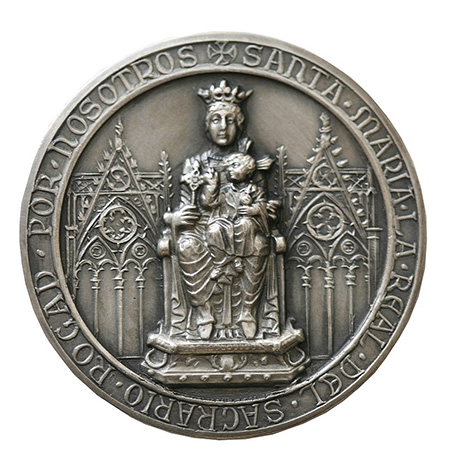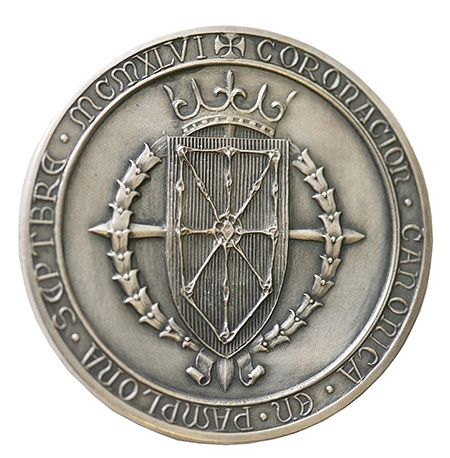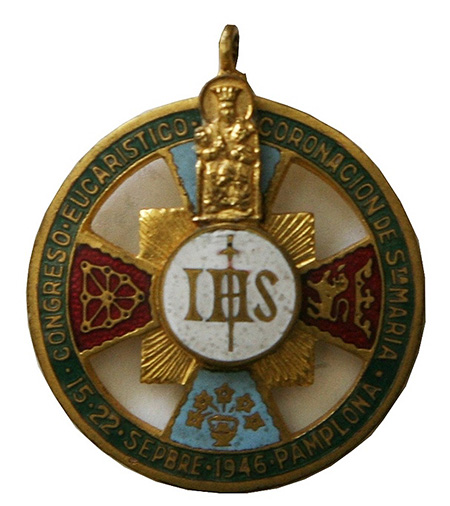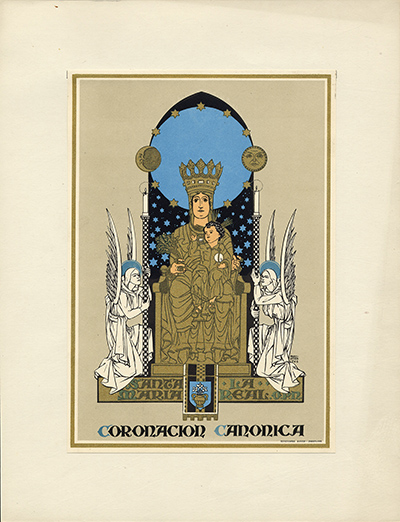The piece of the month of September 2017
DECORATIVE ARTS AROUND THE CORONATION OF THE VIRGIN OF THE TABERNACLE (1946)
Eduardo Morales Solchaga
Chair of Navarrese Heritage and Art
"SANTA MARÍA LA REAL DE PAMPLONA/ BLESS THIS TOWN/ THAT REMEMBERS YOUR CORONATION/ PAMPLONA 21 - SEPTEMBER - 1946". These are the words that are written under the niche of the Virgen del Sagrario, located in the bastion of Labrit, in front of the Episcopal palace of Pamplona. To properly understand this fact, which, as we can see, had its correspondence in the decorative arts, it is necessary to go back in time.
Once the Civil War was over, in the early years of Francoism, the religious substratum that had been eradicated from Spanish society during the Second Republic was gradually recovered. These were the times of the so-called national-Catholicism, in which the new regime tried to dissociate itself from the totalitarianisms defeated in the Second World War.
Among the most relevant manifestations of the religious fervor described above was the so-called "Marian canonical coronation". This rite arose in Italy in the 17th century and remained confined to that territory until the end of the 19th century, when it was included in the Roman Pontifical, thus extending to the entire Catholic world. In Spain, the process began in 1881 with the coronation of the Virgin of Veruela and continued uninterruptedly until the Second Republic, when only three images were crowned, two during the Reformist Biennium (Virgin of the Forsaken of Valencia and the Virgin of Health of Palma de Mallorca); and one during the Radical-Cedist Biennium (Virgin of Sonsoles of Avila). After the Civil War the internship was reactivated with great fervor (Virgen del Coro de San Sebastián-1940), maintaining a good pace until today (Virgen de Butarque-2017).
In the case of Navarra, the first to be crowned was the Virgen del Romero de Cascante (1928), followed by the Virgen del Sagrario of the Cathedral of Pamplona (1946), the Virgen de Ujué (1952), the Virgen del Villar de Corella (1956), the Virgen del Puy de Estella (1958), the Virgen de Roncesvalles (1960); and, more recently, the Virgen del Yugo de Arguedas (2010). All of them generated expectation, literature and art, although the most remarkable one was the Virgen del Sagrario, which since then has been known as Santa María la Real.
The coronation of the Virgin of the Tabernacle, titular image of the Pamplona Cathedral, as Queen of Navarre, took place during the Eucharistic congress , celebrated in the capital of Navarre from September 15 to 22, 1946. Apart from the aforementioned congress, of diocesan character, the most outstanding event was the closing procession, in which the cathedral image was accompanied by numerous relics and more than thirty Marian images from different parts of Navarre, such as: Our Lady of Roncesvalles, the Virgin of Puy de Estella, Santa María de Irache, Our Lady of Rocamador de Sangüesa or the Virgin of Ujué, among many others. San Miguel de Aralar, one of the most widespread devotions in the region, did not miss the quotation either, before the astonished gaze of the attendees.
The procession finally arrived at the place of the Castle of the capital, where the Virgin of the Tabernacle was crowned solemnly by Dr. Manuel Arce and Ochotorena, archbishop of Tarragona, who had been named cardinal in February of that year by Pope Pío XI. For it the same rite was followed with which long ago the coronations of the Navarrese kings were celebrated before this image, in a ceremony in which the giants, the brotherhoods, the army, choirs of music, the chapter, Navarrese city councils, and the deputation to the complete one participated, among other many institutions and prominent people. Previously, the image made a stop at the place Príncipe de Viana, where 16,000 children received communion, in the largest mass communion in the history of Navarre. As the chronicle of the coronation narrates: "the final apotheosis of the act had moments of great spectacularity. Airplanes flew overhead, dropping petals on the place. The artillery fired 21 cannon shots from library assistant. The band played the Royal March. All the dancers present performed their repertoire of dances. Hundreds of pigeons were released in the vicinity of the altar. The giants of the comparsa of Pamplona danced".
To commemorate these events, two official medals were minted, very different in morphology, materials, promoters and recipients, of which several examples have been preserved in public and private collections (as in the case of the two being studied).
The first one, from profile circular and minted in silver (5.5 cm.), has both sides decorated and bordered by a molded edge. On the obverse, and on a straight field, there is a relief of the image of the Virgin of the Tabernacle framed by two arches of Gothic tracery of the cloister of the cathedral, also in relief, and surrounded by the registration: "SANTA MARIA LA REAL DEL SAGRARIO, ROGAD POR NOSOTROS" (SAINT MARY THE ROYAL OF THE SAGRARY, PRAY FOR US). On the reverse the same model is repeated, with the registration in Gothic letters: "Coronación Canónica en Pamplona Septbre MCMXLVI" in the border and the coat of arms of Navarre with the laureate of San Fernando, granted by General Franco after the Civil War, in the field.

Plate 1: Medal for the coronation of Our Lady of the Tabernacle, 1946. Obverse

Plate 2: Medal of the coronation of the Virgen del Sagrario, 1946. Reverse
As for its origin, it was minted by order of the Diputación Foral de Navarra, which in session of July 22, 1946 approved the model that was actually followed, also conserving more modest copies in bronze and aluminum. Nothing is known of its author, although the recipients are known to be "prelates, adopted sons and representations, who had been his guests". Among the Pamplona institutions that received this gift and that still keep it today are the Pamplona City Council, which contributed to the event with the not inconsiderable sum of 100,000 pesetas, and the Cathedral Chapter, owner of the crowned image. A bronze copy was awarded by the Provincial Council to Mr. Ignacio Baleztena Ascárate, for his role as master of the backbone of such a singular ceremony.
The second (3 cm.), is of circular profile and only decorated on the obverse. It inscribes in its interior a Greek cross, openwork and trimmed, of trapezoidal arms, and circular square, in which the anagram of Christ is set on a white enameled background, from which four beveled beams of rays depart. In the upper part there is a turned ring from which once hung - as can be seen in other preserved specimens - a band of white and yellow cloth, the colors of the Vatican. The circular edge of the medal, enameled in green, presents the registration "Coronation of St. Mary. congress Eucharistic. 15 - 22 - Sepbre - 1946 - Pamplona" in golden letters. The arms of the cross are enameled alternately in blue and red, on the first ones there is a relief of the Virgin of the Tabernacle, and a pitcher of lilies, emblem of the Pamplona church, while the second ones frame the coats of arms of Navarre and Pamplona, all this on a golden structure.

Plate 3: Medal for the coronation of Our Lady of the Tabernacle, 1946.
The origin of the same is found in the local press: "The board organizer of these two great religious solemnities that are going to take place in Pamplona, together with the coronation of Our Lady of the Tabernacle, has C the model official commemorative medal, which will be worn on their chest by so many thousands of Navarrese as they are to concur in Pamplona from September 15 to 22 of this year.... we have nothing to say in view of the beautiful design that has been devised for the medal, because it gathers, with dignity, all the motifs that concur to the solemnities that all Navarre will celebrate".
Therefore the addressee of the same one, quite more modest than the previous one, was the faithful people of Navarre, to whom another subject of souvenirs were also offered, as for example stamps, posters, stamps, manuals or congressman cards, that could be acquired in the small chalet of the administration of the tombola of the charity, located in the Paseo de Sarasate. In the case of the medal, four versions were minted: model needle (2 pesetas), model silver-plated (5 pesetas), model enamel (10 pesetas) and model gold-plated (15 pesetas). The one presented here corresponds to the third of the models, and the gold and silver ones are also preserved in private hands, respectively.
Regarding design and iconography, it corresponds to the multifaceted artist Leocadio Muro Urriza (1897-1987). In the words of José María Muruzábal, he has not been properly valued because of his work professor within the School of Arts and Crafts of Pamplona, and the wide variety of artistic techniques he worked with: painting, decoration, posters, murals, miniature on parchment or design. For the aforementioned author, Muro Urriza was, above all, an exceptional draughtsman, although his controversial personality -a reserved man, not very fond of big artistic events and exhibitions- has not contributed to the correct evaluation of his artistic production.
Muro Urriza collaborated actively with the Diocesan Church of Navarra. In fact, he was also in charge of designing the poster of the event that has been explained here, and a print, preserved in the General file of Navarra. It is a beautiful three-color chromolithograph (32 x .5), of neo-Gothic evocations, in which the enthroned image of Santa María la Real is presented, with golden mantle and crown, flanked by two angels that illuminate her with their respective candles. Above her, the starry blue sky stands out, in which there are also such Marian attributes as the moon and the sun(electa ut sol, pulchra ut luna). Hanging from the throne and on a podium, a hanging with the emblem of the cathedral of Pamplona can be appreciated, to which previously reference letter has been made reference letter. In the same place is read "SANTA MARIA/ LA∙REAL∙∙D.P.N." and at the foot of the composition reference letter is made to the "CORONACIÓN CANONICA".

Plate 4. Poster of the Coronation of the Virgen del Sagrario, by Leocadio Muro Urriza (Photo: file Real y General de Navarra).
As far as the printing is concerned, as it says in the lower right corner, it came from the presses of Ediciones Eguin, a printing house located at 23 Bergamín Street in Pamplona. A few days after the Coronation, the following was announced in the Pamplona press: "Ediciones Eguin will soon publish a true album of photographs printed in three colors, on excellent paper, and a quick description of the events held in our city from September 15 to 22. It also includes all the Marian images of Navarre that were in Pamplona, and pictures of their coming along the roads from the villages. The great photographic report of Zubieta, with a lyrical and really descriptive text of this great page of the History of Navarre. Photographs and text, as a whole, will revive in the pages of this album the great solemnities celebrated". The aforementioned album was sold, under previous reservation, at 10 pesetas per unit.
The coincidence of both the subject matter and the colors announced by the printer make it seem safe to assume that the print was part of this collection. It is certainly also the cover image in three colors of a small description of the festivities entitled "Día grande de la coronación de Santa María la Real y triunfo de Jesucristo Sacramentado", published under the authorship of Muro Urriza himself, that same year in the aforementioned publishing house.
SOURCES AND bibliography
-Journalof Navarre (1946)
-file General de Navarra: ES/NA/AGN/13-2/FIG_RETRATO,N.208
-CORELLA ESTELLA, F., Navarra por Santa María: breve crónica de la coronación canónica de Santa María la Real de Pamplona celebrada en los días del congress Eucarístico Diocesano de 1946, Pamplona, 1946.
-MORALES SOLCHAGA, E., "La colección de medallas del Ayuntamiento de Pamplona". programs of study de Platería: San Eloy 2013, Murcia, 2013.
-MURUZÁBAL DEL SOLAR, J.M., "Leocadio Muro Urriza". Pregón Siglo XXI, nº 23 (2004), pp. 44 - 51.
